Inventions
Machine to Cure Headaches
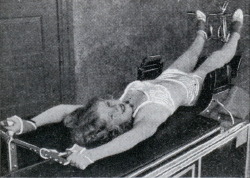 Image from modernmechanix.com. Text from the Salt Lake Tribune, Dec 10, 1939:
Image from modernmechanix.com. Text from the Salt Lake Tribune, Dec 10, 1939:Sufferers from chronic headaches may be interested in the contrivance pictured herewith. The inventor calls it a mechanical chiropractor and he says that through its use it is possible to find relief from headaches, poor circulation and indigestion.
The machine is somewhat complicated but it is said to put a patient through a course of exercises as vigorous as those employed by a skilled chiropractor. It is said to also correct curvature of the spine, weakness and many other ailments in the treatment of which the average chiropractor specializes.
Posted By: Alex - Mon Feb 23, 2009 -
Comments (8)
Category: Inventions, Medicine
Albert Bacon Pratt’s Helmet Gun
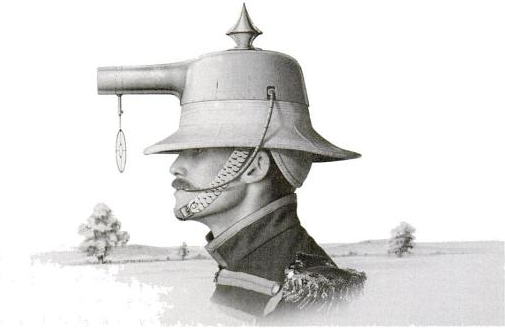
In 1916 Albert Bacon Pratt of Lyndon, Vermont was issued patent No. 1183492 for a "gun adapted to be mounted on and fired from the head of the marksman." The wearer fired the gun by blowing into a tube. Most of Pratt's patent application is fairly dry and technical, but here he offers his thoughts on some of the advantages of his invention:
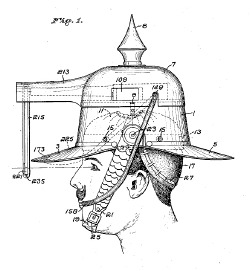
Pratt then points out that his invention is useful not only in combat, but also in the kitchen:
Pratt claimed he had solved the problem of recoil:
But I suspect he didn't have all the bugs ironed out, which must be why such a useful invention never caught on.
Posted By: Alex - Fri Feb 20, 2009 -
Comments (14)
Category: Inventions, Patents, Weapons
Cell Mate
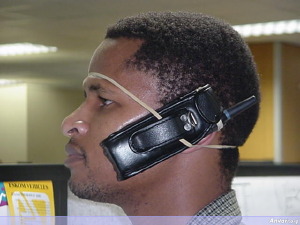 Remember that picture of a "hands-free cell phone" that circulated around for years?
Remember that picture of a "hands-free cell phone" that circulated around for years?I couldn't help but think of it when I saw the "Cell-Mate" hands-free device being sold by Laser Products Industries. Seriously, why not just use a rubber band? It would be a lot cheaper.
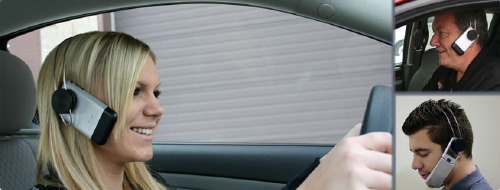
Posted By: Alex - Sat Jan 10, 2009 -
Comments (3)
Category: Inventions
Book Holder Bracelet
 I can see the utility of a book holder. Often use them myself. But a book holder on your wrist? Maybe if you wanted to read while driving...
I can see the utility of a book holder. Often use them myself. But a book holder on your wrist? Maybe if you wanted to read while driving... From Popular Science, Apr 1930:
What might be a convenience to readers is a unique wrist attachment recently designed for holding magazines and small periodicals open before the eye at arm's length. This novel book holder is a bracelet fitting snugly about the forepart of the wrist, to which is fixed a small bracket firmly supporting the periodical just as the "lyre" of a cornet supports sheet music.
The device is adjustable to any wrist and may be obtained in sterling silver or nickel, silver, or gold plated.
Posted By: Alex - Fri Jan 09, 2009 -
Comments (3)
Category: Inventions
Human Body Flinger
This invention promised to stop people from getting run over by trucks by violently flinging them out of the way. I don't know why it never caught on. From Popular Science, Feb 1931:Designed to prevent pedestrians from being run over, a British motor truck has a large roller before its front wheels, which rotates in the opposite direction to the wheels. If a person is knocked down the tires cannot touch him, since the roller's reverse rotation throws him away from the vehicle. It thus has time to stop before doing him serious injury.

Posted By: Alex - Tue Jan 06, 2009 -
Comments (6)
Category: Inventions
Lamp Cord Lighter
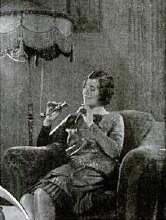
An electric lamp cord suspending a heating element from which the smoker can light his cigar or cigarette is the latest novelty for the living room. The lighter comes in a variety of colors to match the twisted silk-covered wire cord and so has the appearance of a tassel at the end of the cord. Pressing a button turns on the electric current for the heating element. Another switch, located higher on the cord, governs the lighting of the lamp. The device is installed by simply unscrewing the electric light bulb, screwing in a special socket, and replacing the bulb.
Actually, I don't think it would be that hard to make something like this. I'm pretty sure you can buy all the parts off-the-shelf (heating element, cord, etc.). Maybe I'll go into business selling these on eBay.
Posted By: Alex - Thu Dec 18, 2008 -
Comments (6)
Category: Inventions
The Balloon Chair
I'd like to use this the next time I travel by airplane. From Popular Science, Sep 1937: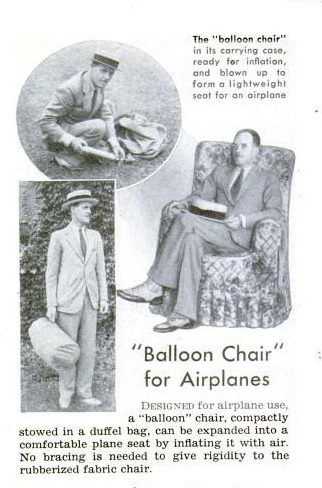
There are more details about it in the Oct 1937 issue of Popular Science.
Posted By: Alex - Sat Dec 13, 2008 -
Comments (0)
Category: Inventions, Travel
Franz Reichelt
On February 4, 1912 Franz Reichelt fell to his death from the Eiffel Tower. From Wikipedia:Now check out the video:
Posted By: Alex - Mon Dec 08, 2008 -
Comments (6)
Category: Death, Inventions
ACM Wallet
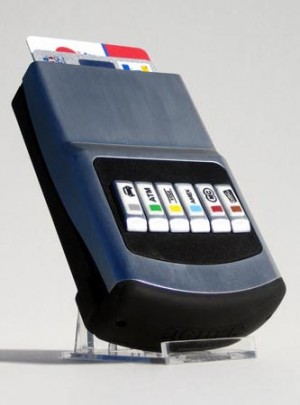

Posted By: Paul - Fri Oct 31, 2008 -
Comments (5)
Category: Business, Products, Inventions, Chindogu, Money
Hoberman Arch
Six years have passed since the whole world saw the wonderfully weird portal created by Chuck Hoberman, but it's never too soon to admire it again.Wouldn't you want a small version of this in your home?
Posted By: Paul - Thu Oct 30, 2008 -
Comments (10)
Category: Inventions, Sports, Technology, Television

| Who We Are |
|---|
| Alex Boese Alex is the creator and curator of the Museum of Hoaxes. He's also the author of various weird, non-fiction, science-themed books such as Elephants on Acid and Psychedelic Apes. Paul Di Filippo Paul has been paid to put weird ideas into fictional form for over thirty years, in his career as a noted science fiction writer. He has recently begun blogging on many curious topics with three fellow writers at The Inferior 4+1. Contact Us |




